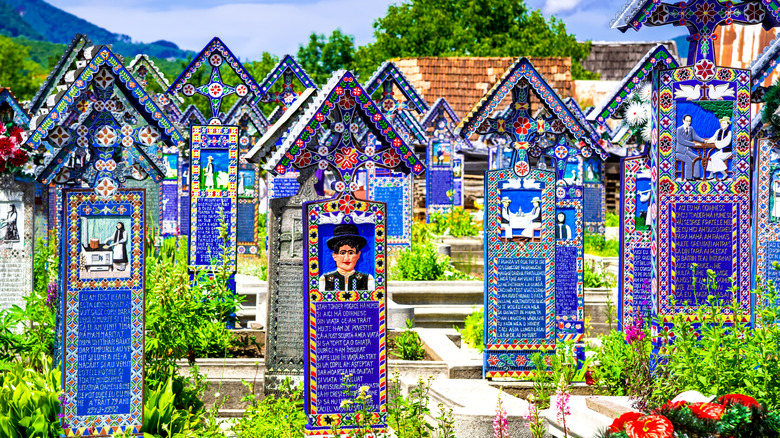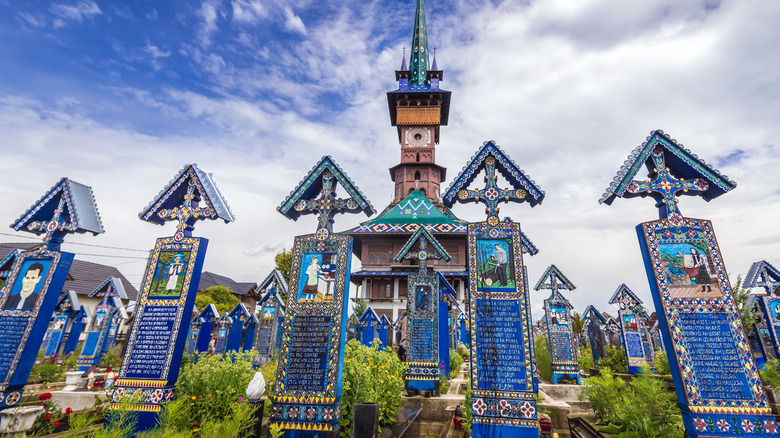Rick Steves Recommends This Offbeat European Cemetery That's A Melting Pot Of Whimsy And The Macabre
Cemeteries might not make the top of your traveling must-see list, but maybe they should be. Far from just being somber resting places, they're essentially open-air museums exhibiting a culture's relationship with mortality and grief. In some cases, cemeteries reveal just as much about the living as they do about the dead — what people cherish or fear, and how they choose to remember the departed. Travel expert Rick Steves recommends visiting cemeteries, pointing out that the macabre corners of Europe offer some of the most fascinating insights into history and tradition. Take, as an example, the offbeat French cemetery of Aître Saint-Maclou, which holds evidence of the Black Death's devastation.
In Romania, however, there's a cemetery that's completely unique, and one that Rick Steves calls "a poignant celebration of each individual's life, a chronicle of village history, and an irreverent raspberry in the face of death." Welcome to the cheekily named Merry Cemetery, found in the village of Săpânța. Measuring up to its name, Business Insider has even dubbed it "the world's happiest cemetery." So what makes it so remarkable? Instead of the usual gray tombstones and heavy symbolism, here you'll find rows of vividly painted wooden crosses, each featuring playful folk art and a short, often darkly humorous poem about the person's life — and sometimes, their unfortunate demise.
Romania's Merry Cemetery laughs in the face of death
The Merry Cemetery owes its existence to one man named Stan Ioan Pătraș, a local wood carver born in 1908 who, rather than crafting traditional gravestones, started carving bright wooden crosses. He painted them with scenes from the deceased's life and added witty epitaphs in the local dialect. The vibrant blue he used so frequently even became known as "Săpânța blue." Today, more than 800 of these unique grave markers fill the cemetery, many of them created by Pătraș himself. After his death, his apprentice, Dumitru Pop, took over the tradition, and to this day, new crosses continue to be made in the same colorful, storytelling style.
When a family commissions a cross, the artist researches the person's life, crafting a poem that's honest — sometimes brutally so — but without being mocking. "The families actually want the true life of the person to be represented on the cross," Pop told The Toronto Star. Some verses poke fun at bad habits, like one gravestone dedicated to a heavy drinker, which translates to: "I drank a lot,/ and now, I'm still thirsty./ So you who come/ to my resting place,/ Leave a little wine here." Others, nonetheless, are more heartfelt. One, translated by Denisa Murzea in Mappola, reads: "As long as I lived on earth/ Everything of beauty I loved." Each cross is also illustrated with a scene from the deceased's life: a woman cooking, a farmer tending his land, or, in a more morbid case, someone with a gun to their head.
Tips for visiting the Merry Cemetery
Visiting the Merry Cemetery requires a small entrance fee, and it's open during daylight hours. Note that, since all the grave markers are written in Romanian, it's a good idea to bring a translator to understand the whimsy of the poems inscribed. Right next to the cemetery, you'll find the equally colorful Church of the Assumption marking the location. Check out the Stan Ioan Pătraș Memorial House, open every day except Monday, to learn more about the man who started it all. Just outside the cemetery, local vendors sell folk crafts and Romanian bites. Depending on how busy it is the day of, free parking spots can fill up quickly (though you can find private parking nearby for a fee).
To get to Săpânța, the nearest major airport is in Cluj-Napoca, about three and a half hours away by car. You can also take a train to Sighetu Marmației, the closest city with more accommodation options, and then drive a little over 20 minutes west to the village. Alternatively, you could stay in Baia Mare, a larger city about an hour and a half away, which is also worth visiting while exploring the Maramureș region. Just be prepared — Romania has been called Europe's most dangerous country to drive in, but also one of the most beautiful.


